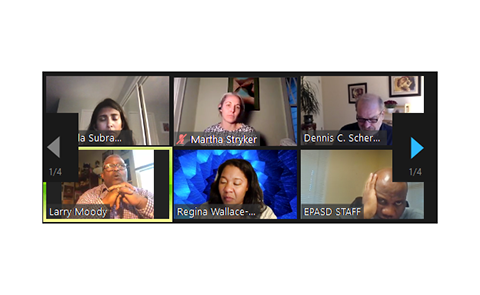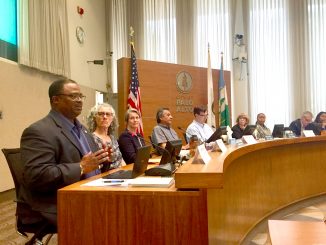
BY EMILY MIBACH
Daily Post Staff Writer
A breakdown in the Zoom conferencing platform created chaos when the East Palo Alto Sanitary District board was trying to make a crucial decision about providing sewer service to a low-income housing development.
Whether Zoom broke down because the host had run out of time or somebody’s internet was cutting out wasn’t clear. But it got in the way of the sewer board, city officials and representatives of EPACanDo from negotiating a deal Thursday that would allow the addition of 91 apartments to the Light Tree apartment complex at 1805 E. Bayshore Road.
The issue is how much should the housing development pay to connect to the city’s sewers.
If EPACanDo doesn’t get a letter from the sewer district by June 14 saying it will hook up the apartments, a $20 million state grant the city has secured for the project will be rescinded.
A key question is how much should EPACanDo pay? The sewer district says its pipes have reached capacity and past their useful life, and they need money from developers to renovate the sewer system.
How much?
Initially, the sewer district was asking EPACanDo to pay $4 million for the hook-up. Then it dropped the amount to $2.6 million.
Last night, sewer district manager Akin Okupe was going over his calculations as to how much EPACanDo ought to pay when his internet froze up, and a few minutes later, board members and the 40 or so viewers of the meeting were kicked off due to the meeting timing out on Zoom.
So it wasn’t clear what the district is asking for the hook-up. But city officials who attended the meeting pointed out that since the district doesn’t have a rate sheet for hook-ups, the amount EPACanDo should pay isn’t set in stone.
City officials who participated in the meeting included Mayor Regina Wallace-Jones, Councilman Larry Moody, Assistant City Manager Patrick Heisinger and Public Works Director Kamal Fallaha.
It appeared the sewer board and the city agreed that they would work together with EPACanDo to come up with an agreement in time for a special meeting next Wednesday that would resolve the issues.
Because of difficulties with the Zoom platform, it was unclear whether the parties agreed to an amount for the hook-up.
The meeting had a number of abrupt interruptions, causing for speakers to be cut off. Frustrations mounted as district officials struggled with tech issues.
Sewer board member Betsy Yanez said that the district had upgraded its Zoom account to run longer meetings, and was not sure why the meeting kept ending. People also had trouble logging into the meeting altogether, and ultimately Wallace-Jones posted the link to the meeting in the Facebook group East Palo Alto Neighbors so people could watch and participate in the meeting.




Despite the technical difficulties at our EPASD May 14 Special Board Meeting, The necessary work was accomplished by the decision makers at both EPASD and the City. I made the motion to direct Mr. Okupe to work with City staff to create the necessary documents to ensure that the City/Light Tree has a “Will Serve” letter, and that all proper engineering and construction work has been completed prior to the City allowing the new Light Tree to be occupied.
It seems that we got together and created the means by which the City can retain $20 Million in State funds to be used for construction at the Light Tree. I expect that this will all be ratified at EPASD’s June 4 Regular Board Meeting.
Additionally, I pledged support for an EPASD/City agreement that would set aside 100,000 gallons per day of EPASD capacity at the Palo Alto Regional Water Quality Control Plant. This reserve would be for low and very-low income housing only. Just as the massive proposed development will exhaust EPASD’s system capacity to transport wastewater, full build out of the City’s General Plan will demand more wastewater treatment capacity than EPASD owns at the treatment plant. The set aside will guaranteed that approximately 420 units of low/very-low income housing can be served without having to pay surcharge for new capacity, nor have to wait if treatment plant expansion is required. I intend to return this item to the June 4 EPASD agenda. Thank you.
So Dennis what you’re saying is that the district, which originally wanted $4 million from the developers of this project, is now going to give away the sewer hook-up for free? How do other developers get that deal? Is this because it’s low-income housing? Has the district board established and voted upon a criteria for who gets free hook-ups? Is it based on the “goodness” of the developer. Will Priscilla Chan’s The Primary School, which is certainly built upon the intention of doing good, qualify for this freebee? The Sobrato family has given millions to the San Jose Diocese of the Catholic Church. Do they qualify for a free hookup?
It is illegal for EPASD to waive connection fees. We do not and have not waived connection fees. There are no freebies, it’s quite illegal, including the Light Tree Apartments.
The core issue surrounding sewer service for the Light Tree expansion is a “Will-Serve” letter to be provided by EPASD, and what that letter is to say. Currently, Light Tree Apartments have 97 units. When future collection system needs are evaluated, a Will-Serve letter is easy to provide for 97 units. The capacity already exists for those units. There are no “free” units being given away
The Light Tree project proposes adding 90 units in addition to those 97. These additional units will require connection fees. No waiver of these fees has been proposed, requested or discussed.
Finally, EPASD does not require downstream infrastructure upgrade fees be paid to them. It is perfectly acceptable for the developer to finance and perform the construction. EPASD exercises engineering inspection and oversight of such construction within the District.
I did propose that EPASD set aside 100,000 gallons per day of futuure treatment capacity for low/very-low income housing. Should the City’s development ambitions exceed the Palo Alto Regional Water Quality Control Plant’s wastewater treatment capabilities, acquiring additional treatment capacity will be an exceptional challenge. If the City wants the set-aside of treatment capacity for low/very-low income housing, I’m confident that the EPASD Board will approve it.